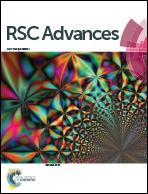Graphitic carbon nitride nanosheets with tunable optical properties and their superoxide dismutase mimetic ability†
Abstract
Fluorescent graphitic carbon nitride nanosheets (g-CNNSs) have attracted extensive attention because of their new properties and promising practical application. The design and construction of g-CNNSs with novel optical properties is highly desirable. Herein, g-CNNSs with tunable optical properties were synthesized through a simple, nontoxic and one-pot solid-phase thermal treatment method. The g-CNNSs exhibited a strong absorption at 410 nm in a UV-vis absorption spectrum and had a fluorescence emission band at around 525 nm over a wide range of excitation wavelengths. The optical properties of g-CNNSs exhibited a regular change in storage or alkaline solution. The g-CNNSs showed low cytotoxicity and high stability of fluorescence intensity under high-salt conditions or in a broad pH range (1–14). Interestingly, the g-CNNSs possess intrinsic superoxide dismutase (SOD)-like activity which is related to their structure.


 Please wait while we load your content...
Please wait while we load your content...